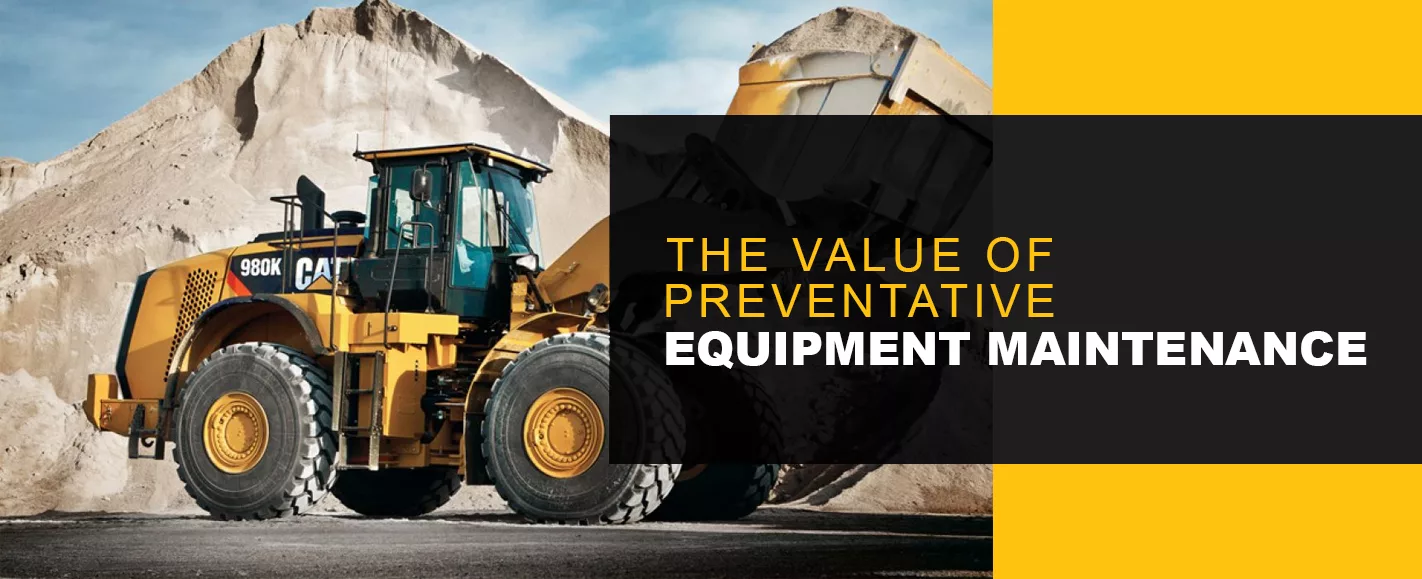

Preventative maintenance for your heavy equipment is seemingly straightforward and something you know you should be doing — yet it easily falls by the wayside.
Why is that? You hardly need reminders on the importance of preventative maintenance for your fleet, the security and profitability that comes with inspecting equipment, making preemptive adjustments and finding issues before system failures strike. And you certainly don’t need to be told the cost-savings that come with proactive rather than reactive repairs — savings which start at lower operating costs and end with a higher resale rate.
Yet the value of preventative maintenance for your heavy equipment is twofold — the kinds that affect your wallet and the kinds that affect your brand.
Preventative equipment maintenance is essential to establishing consistent protocols for protecting the performance and safety of your investment, yes — but it’s even more important to build your business legacy. These days neither can be neglected.
Preventative maintenance is more than caring for and managing your fleet.
These activities are fundamental, keeping your worksites efficient and your bottom lines under control. But when they aren’t backed by a complete understanding of the following, then their actions can’t help but turn empty.
That’s right — we’re starting the list with integrity. That’s because the true value of preventative maintenance lives at the intersection of professional responsibility and personal commitment. It’s a promise you make to yourself, your employees and your clients that you don’t settle for skirting the bare minimum to operate your business. You exceed expectations.
A comprehensive preventative maintenance plan drafted for your fleet helps make this promise a reality. It lends you a stamp of operational integrity, putting your money where your mouth is.
Anyone interacting with your fleet and crew will know the gravity you place on doing things correctly at every stage, every day, not just when problems arise. It’s a commitment that goes a long way to those both inside and outside the industry, with integrity as the backbone to your fleet’s reputation.
Parts replacements, fluids analysis, oil changes — these things might seem like details so perfunctory you hardly pay them mind. But as the saying goes, the difference between something good and something great is in the details.
Few places is this truer than when it comes to heavy equipment safety. Preventative equipment maintenance schedules prioritize safety because they aren’t satisfied with the surface appearance of things. They dig deeper, identifying risks or inefficiencies before they turn into real safety hazards, improving end-to-end safety and making the conditions for everyone who sets foot on your worksites a priority.
Neglected equipment is more likely to be fuel inefficient, stall, stutter, overload or see entire system failures. This means unplanned downtimes and scrambling to find and fix errant parts — which, in turn, means idle employees, halted production and hits to your bottom line that you may never recover.
If that weren’t enough, consider the broader implication of how all this comes across to the outside world. When contracts aren’t followed, timelines fall behind or costs consistently balloon, you curate the impression this is just “business as usual” for you and your crew. Once this becomes associated with your reputation, good luck getting it to change.
No business owner, site manager or equipment operator wants to run their operations with so much risk and waste. It runs counterintuitive to the business decisions so at the heart of the industry and the growth mindset it takes to succeed.
Adopting a preventative maintenance plan for your heavy equipment not only helps you with the intrinsic values described above. It carries serious bang for your buck.
That’s because the monetary value of preventative maintenance comes down to operating costs — how it affects them, preempts them, informs them and ultimately reduces them. See for yourself the numbers-backed relationship between maintenance plans and operating costs in step-by-step detail below.
The following values are used to calculate the actual operating costs of a piece of heavy machinery or equipment, both for their annual, cumulative rates or if looking to budget costs by the hour:
Overall, the cost of owning and operating heavy equipment is substantial. Conservative estimates put fixed cost figures between $25,000 and $35,000 annually depending on the type of equipment, while others can run upwards of $80,000.
Repair costs are those accrued from unexpected equipment breakdowns. They can affect single components like an injector or — worst-case scenario — lead to complete and exorbitant system failures.
Repair costs are not factored into the fixed operating cost estimates above. The reason for this is intuitive — there’s simply no way to predict these breakdowns ahead of time — that is, no way without a preventative maintenance plan.
Preventative maintenance plans are the fundamental way to address all the equipment expenses described above — both fixed operating estimates and repair costs.
In fact, studies have found that in total, reactive maintenance — like those with repairs and unplanned servicing expenses — cost businesses three to four times more than the average preventative maintenance plan. That alone makes these plans worth their salt.
Still not convinced? Consider how preventative maintenance targets nearly every operational variable, risk and cost involved in owning heavy equipment:
Preventative maintenance is an investment. A little today goes a long way tomorrow, with plans translating into a leaner business budget and improved resource allocation backed by tangible costs-savings, not just feel-good practices you don’t know are paying off.
In other words, the money you put in it today will see its value compounded tomorrow to mitigate the following concerns:
Providing diagnostics, mitigating repairs, reducing idle hours and fuel burn, improving fleet hours — these outcomes are at the heart of preventative maintenance’s value and are what operators and managers come to expect when following a plan.
Yet no matter the plan, provider or customer service agreement, the overall goal of preventative maintenance remains the same — to create consistent administrative and operational protocols so that your most significant investment — your fleet — is optimized for years to come.
Condition Monitoring and Control sees things about your machines eyes and ears can’t.
Simply put, it’s a digital-analytic system allowing you to monitor your fleet remotely, in real time. The software produces full health reports through the assistance of data analysts and technical experts so you can fully assess its contents, interpret information and create tailored, cost-effective action plans.
These action plans provide the blueprint to scheduled repairs, equipment enhancements and other services included in the customer service agreement, helping the machines run as profitably as possible.
Fluid inspections and analysis are the backbones of preventative maintenance. They’re so important, some industry experts have even likened them to taking a blood test. You simply can’t understand the true internal workings of your equipment without one.
The fluids-analysis arm of preventative maintenance will set up scheduled sample fluid extractions from your machines. They’ll port these samples quickly to a lab, where in-depth tests will be performed on oil, fuel and coolant liquids. There, everything from microbial growth to trace metals can be analyzed to identify the component likely at their source. For example, high levels of chrome in an oil sample could point toward ball-bearing wear and tear, which you can then proactively address.
TA inspections take a microscope to your machines. They are equally vital parts of a preventative equipment maintenance plan and will likely assess all major machine parts and systems, including:
Lube services are another key element in planned maintenance agreements. From swapping out waste oils and coolants to properly filtering in new fluids in preparation for changing weather, a lube service package takes a considerable condition and maintenance concern off your shoulders.
Some preventative maintenance partners in Utah, like Wheeler, even offer Mobile Lube Servicing. Lube trucks fully outfitted to complete sampling and fillings come to your worksite, on your time, wherever and whenever it’s most convenient, not the other way around.
A name like Caterpiller isn’t trusted because it’s big. It’s trusted because it manufactures machines that get the job done, time and time again.
This is no different to what a quality preventative maintenance customer agreement can do. When you have a reliable team of partners helping you not only maintain but maximize your fleet — and doing so reliably and expertly — then you’re on your way to the safe, savvy and integrity-first operations so imperative to our industry.
Simply put, this is why we at Wheeler Machinery Co. provide complete preventative maintenance plans backed by Cat®-branded parts, components, technology, training and more. It’s a full suite of services to ensure the heavy-equipment stars in your lineup don’t fade — at least under your watch.
Cat is proud to offer two convenient online platforms to take your fleet monitoring to the next level: My.Cat.com and VisionLink. My.Cat.com is a digital equipment hub that allows you to monitor and manage your entire equipment fleet – including Cat and other equipment brands – anytime and anywhere! VisionLink is a complete telematics solution that provides equipment data down to the minute on machine locations, when they are running, opportunities to increase productivity and more. To take this a step farther, the VisionLink Unified Suite is now available, which provides actionable machine data to help make informed decisions on logistics, equipment service, and more to improve your bottom line.
Put simply, My.Cat.com provides an overview of data for an entire fleet, while VisionLink provides granular data about individual machines. Using these online connectivity tools can make managing your fleet’s service needs easier than ever before.
Wheeler Machinery Co. is in the business of helping your business, one machine at a time.
It’s why we say we partner for your success — and mean it. Headquartered in Salt Lake City, Utah, but serving clients as far as Wyoming and Nevada, we have 10 flagship regional offices and 75 field-service trucks to fully deliver on our service promises.
Wheeler is especially proud of its range of preventative maintenance packages. You call the shots through a custom Customer Service Agreement, then we provide the solutions, from routine TA inspections and replacement-part sourcing to our mobile lube servicing.
Give us a call at (435) 789-0635 or reach out online to learn more about our preventative maintenance offerings, or inquire about a direct service today.